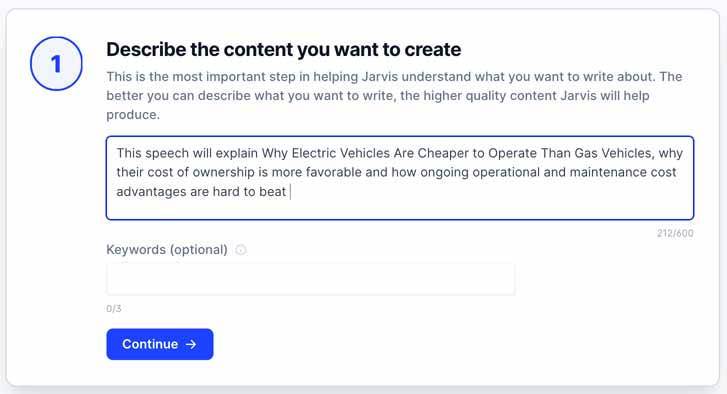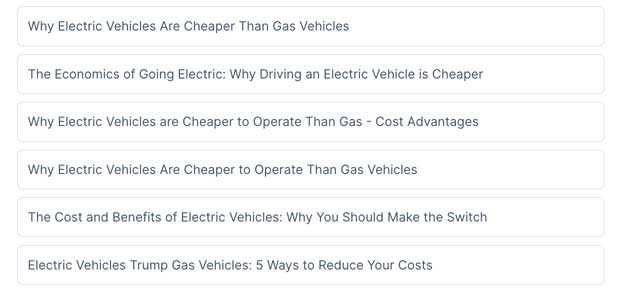If you've ever had to write a speech that truly connects with people, you know how difficult it can be to do it from scratch.
People's attention spans are getting shorter every year and the need for clear and effective language is now more critical than ever.
Well, this no longer has to be the case! AI writing assistants are now making this process much easier by providing templates that can generate all the content you need.
These templates allow anyone who needs to get quickly to the first draft of their speech to do so in minutes rather than hours.
This article will cover how these AI writing assistants work, how they benefit business owners and how they can eliminate writer’s block from your future.
Key Takeaways
Disclosure: Although I receive affiliate compensation at no additional cost to you to support this site that compensation in no way influences my recommendations, which are strictly informed by my 10+ years of online business experience consulting for clients large and small. My aim is to always recommend tools that offer the best return for your investment (for more details, read my Affiliate Disclosure).
The Basics of Writing a Speech
Before we jump on the AI writing tools and how they work, let's get the basics of writing a speech out of the way.
Speech Title
The first step in creating a speech is to create a title that captures its thesis. For example, “Why Electric Vehicles Are Cheaper to Operate Than Gas Vehicles.”
Introduction
The second step is to come up with an introduction that explains the key problem presented by your thesis and why you’re qualified to talk about it.
So, you may begin by introducing yourself and mentioning that you’ve been managing a fleet of service vehicles for your company for the last seven years. Now, you’ve been tasked with looking into electrification as a way to lower costs and reduce your company’s carbon footprint.
Main Points
The third step is to create the body of your speech, breaking down how you’ve approached your problem into separate points and describing your key findings.
For example, your first point may talk about fuel costs, your second point about regular maintenance costs and your third point about general upkeep costs.
Conclusion
The fourth and final step is to conclude your speech summarizing your key findings into a takeaway. For example, you may show the large savings of operating and ownership costs between an electric vehicle and its gas counterpart.
How Can AI Help With Speech Writing?

AI-based writing is a new and exciting technology that takes advantage of deep learning techniques to automatically generate human-like written content.
These tools make use of neural networks and natural language processing to “learn” how to write through the rapid iterative process of “reading” tens of millions of web pages.
In essence, AI programmers train these machines over and over and over again until they can teach themselves how to write as well as a skilled human writer.
A Word of Caution
While AI writing assistants are able to generate impressive content, keep in mind that they do not have expertise nor experience in any topic they can write about.
So, while they’ll be able to write quite convincingly, you need to make sure to revise, correct and improve upon the text through the filter of your own experience.
Treat all AI-generated facts as a placeholder for your own information — they’re writing assistants, not writer replacements!
How to Write a Speech in Minutes With AI Writing Assistants
Let’s move on to the fun part!
For this exercise, I’m going to use Jarvis.ai, one of the top AI Writing Assistant software tools on the market and a popular choice among writing professionals. Other popular tools are Rytr (review here) and Growthpro.
To speed things up, I’ll reuse the example about electric vs. gas vehicles as the subject of our speech.
I’ll use the title in the example above, and use Jarvis to come up with a more engaging version by using the content creation template called Long-Form Assistant.
The first step is to briefly describe the nature of the speech to give Jarvis some initial guidance:
“This speech will explain why electric vehicles are cheaper to operate than gas vehicles, why their cost of ownership is more favorable and how ongoing operational and maintenance cost advantages are hard to beat”
...and then enter this text into the template:

Upon clicking Continue the title generator will appear, as shown below:

Then I’ll click the Generate ideas button and choose an AI-generated title among the various options:

For this exercise I’m going to choose suggestion number 5: “The Cost and Benefits of Electric Vehicles: Why You Should Make the Switch”
I feel this title addresses the speech’s audience more directly than:
“Why Electric Vehicles Are Cheaper to Operate Than Gas Vehicles”
which is more about the technology than the end user.
Next, let’s build on the original speech introduction by using Jarvis’ Personal Bio template:
Here’s my input:
“I've been managing a fleet of service vans for ABCD & Co. for the last seven years and I’ve been tasked with looking into electrification as a way to lower costs and reduce my company’s carbon footprint.”
And here’s is Jarvis’ output:

Awesome! Now, it’s just a matter of fine tuning the intro a little bit and personalizing it as needed (maybe you have a college degree or a certification?)
The next step is to expand on the speech’s main points. From the example above, our main points are:
- Fuel costs
- Regular maintenance costs
- General upkeep costs
Let’s now use Jarvis to expand on each one of these points by using the Blog Post Intro Paragraph template:
Point 1: Fuel Costs

Clearly, you would replace all placeholder text with real-world data, but other than that, this is a great start!
Let’s see what Jarvis has to say about our next point:
Point 2: Regular Maintenance Costs

After switching placeholder data for real data, this is also a great section intro to build on.
Finally, let’s run our final point through the writing assistant:
Point 3: General Upkeep Costs

Great! A few placeholder facts to replace and we’re in good shape for a strong first pass.
Finally, we’ll use Jarvis to help us write our speech’s conclusion, using the Blog Post Conclusion Paragraph template:

Here's the whole AI-generated first draft:
The Cost and Benefits of Electric Vehicles: Why You Should Make the Switch
Introduction:
My name is John and I am the fleet manager for ABCD & Co.
I have been managing a fleet of service vans for this company for seven years, but recently I’ve been tasked with looking into electrification as a way to lower costs and reduce my company's carbon footprint.
Since then, I've studied up on electric cars, charging stations that are available now, and what the future may hold in terms of battery technology that will allow us to have more range per charge.
Through these studies it became clear to me that there is an opportunity here not only financially but also environmentally so I'm excited about the possibilities!
Main Points:
Fuel Costs:
In the past, fleet operators have been reluctant to switch from fossil fuels to electricity because of the high upfront cost.
However, when considering total costs over a vehicle's lifetime, EVs are cheaper than gasoline vehicles due to lower fuel and maintenance costs. Moreover, they can be charged at night when electricity rates are lowest.
The result is a significant reduction in fleet operating expenses that may offset the higher purchase price of an EV.
The following table shows how electric vehicles compare with gasoline vehicles on key parameters:
*Gasoline prices based on national average per gallon as of November 2017 ($2.37) - Source: Energy Information Administration https://www.*eia.*gov/dnav/pet/hist/LeafHandler?j=
Regular Maintenance Costs:
Fleet operators are always looking for ways to reduce the cost of maintenance. Electric vehicles may be a solution as they require less maintenance than gas-powered cars.
What does this mean for fleet operators? Less downtime due to mechanical problems, which means more miles driven and revenue generated per year.
The savings could total over $4,000 annually on the average car! The increased mileage also helps offset any extra costs associated with purchasing an electric vehicle.
General Upkeep Costs:
In the last few years, there has been a significant shift in the automotive industry from internal combustion engines to electric vehicles.
The benefits of going electric are many and include reducing air pollution and greenhouse gas emissions, improved fuel economy, and improving public health.
However, one major benefit is that electric cars have significantly lower maintenance costs than traditional gasoline powered cars.
In fact, while most people pay an average of $1-$2k per year for maintenance on their car's engine alone (not including oil changes or tire rotations), an electric vehicle would only cost about $300-400 per year for all of its parts combined — especially when it comes time to replace them. This translates to a savings of over 75%.
Conclusion:
If you are looking to save money on fuel, maintenance and upkeep costs for your fleet of vehicles, it may be time to consider electrification.
Fleet owners can lower their operating expenses by switching from diesel or gas-powered fleets to electric ones.
Electric cars also have less carbon emissions than traditional fossil fuels which means cleaner air in the atmosphere all around us!
With so many benefits available with this type of changeover, there is no reason not to give it a try. To learn more about how fleet electrifications work and what they could do for you contact our friendly team today!
Not bad
A few minor changes will be needed here and there, but this is certainly usable as a first draft for our speech.
So, there you have it: a first speech draft from beginning to end done about 10 minutes!
All you have to do now is to add some more facts and personalization, do some spit and polish and you’ll have a final speech draft you’ll be proud of.
By the way, Jasper can do a lot more than writing speeches. It can also write blog post outlines, entire articles, Google ads headlines, business proposals, Amazon product descriptions, and even fiction stories!
Tips for Using AI Writing Assistants for Speech Preparation
While AI writing assistants are a fantastic new technology, they’re not perfect and do require guidance and supervision. Here are some useful tips:
Tip 1: Never trust AI-generated facts and figures
AI writing assistants are trained to put sentences together like a human writer would. But they are not to be trusted with facts — most times, they just make them up to fit the narrative. Never use AI generated facts or figures without validation.
Tip 2: Rinse and repeat until you find a winner
Oftentimes, it takes a number of tries before you get great usable text. If at first the AI content is substandard, don’t give up.
Just keep generating new outputs until you get the one that shines. Jarvis let’s you generate a maximum of 10 outputs at a time.
Tip 3: Sometimes the AI will repeat itself
On occasion the AI writing tool will spit out the same input you provided. In this case, just keep trying until you get original content.
Tip 4: Don’t worry about plagiarism
Jarvis (and most reputable AI writing assistants) have been thoroughly tested with plagiarism tools and always passed with flying colors. All generated text is guaranteed to be 100% original.
Tip 5: The quality of the output depends on the quality of the input
When it comes to AI writing assistants, the old computer adage applies: garbage in/garbage out. If you don’t give them good information, they’ll generate nonsense because they won’t have anything to go by.
Parting thoughts
Now, it’s time for a test drive. Jarvis offers a 7-day money-back guarantee.
Good luck with your speech writing!







